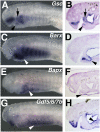Evidence for the prepattern/cooption model of vertebrate jaw evolution
- PMID: 20855630
- PMCID: PMC2951391
- DOI: 10.1073/pnas.1009304107
Evidence for the prepattern/cooption model of vertebrate jaw evolution
Abstract
The appearance of jaws was a turning point in vertebrate evolution because it allowed primitive vertebrates to capture and process large, motile prey. The vertebrate jaw consists of separate dorsal and ventral skeletal elements connected by a joint. How this structure evolved from the unjointed gill bar of a jawless ancestor is an unresolved question in vertebrate evolution. To understand the developmental bases of this evolutionary transition, we examined the expression of 12 genes involved in vertebrate pharyngeal patterning in the modern jawless fish lamprey. We find nested expression of Dlx genes, as well as combinatorial expression of Msx, Hand and Gsc genes along the dorso-ventral (DV) axis of the lamprey pharynx, indicating gnathostome-type pharyngeal patterning evolved before the appearance of the jaw. In addition, we find that Bapx and Gdf5/6/7, key regulators of joint formation in gnathostomes, are not expressed in the lamprey first arch, whereas Barx, which is absent from the intermediate first arch in gnathostomes, marks this domain in lamprey. Taken together, these data support a new scenario for jaw evolution in which incorporation of Bapx and Gdf5/6/7 into a preexisting DV patterning program drove the evolution of the jaw by altering the identity of intermediate first-arch chondrocytes. We present this "Pre-pattern/Cooption" model as an alternative to current models linking the evolution of the jaw to the de novo appearance of sophisticated pharyngeal DV patterning.
Conflict of interest statement
The authors declare no conflict of interest.
Figures



References
-
- Gans C, Northcutt RG. Neural crest and the origin of vertebrates: A new head. Science. 1983;220:268–273. - PubMed
-
- Clouthier DE, Schilling TF. Understanding endothelin-1 function during craniofacial development in the mouse and zebrafish. Birth Defects Res C Embryo Today. 2004;72:190–199. - PubMed
-
- Walshe J, Mason I. Fgf signalling is required for formation of cartilage in the head. Dev Biol. 2003;264:522–536. - PubMed
-
- Thomas T, et al. A signaling cascade involving endothelin-1, dHAND and msx1 regulates development of neural-crest-derived branchial arch mesenchyme. Development. 1998;125:3005–3014. - PubMed
-
- Miller CT, Yelon D, Stainier DY, Kimmel CB. Two endothelin 1 effectors, hand2 and bapx1, pattern ventral pharyngeal cartilage and the jaw joint. Development. 2003;130:1353–1365. - PubMed
Publication types
MeSH terms
Substances
Associated data
- Actions
- Actions
- Actions
- Actions
- Actions
- Actions
Grants and funding
LinkOut - more resources
Full Text Sources
Research Materials

